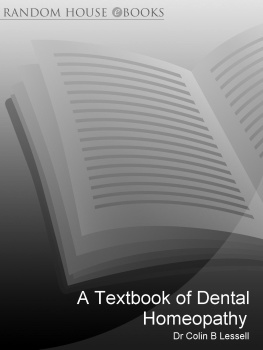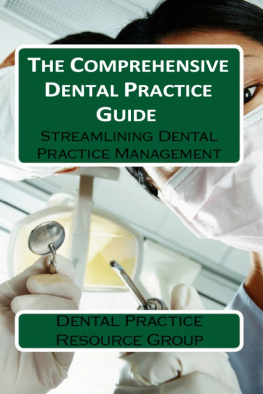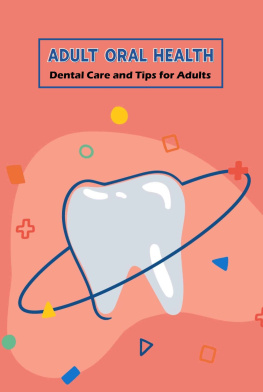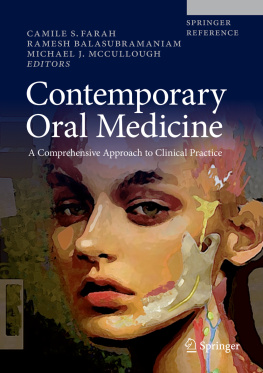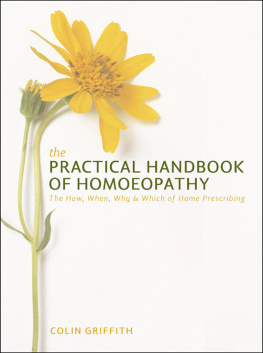About the Book
This book has long been awaited by professionals a complete, modern, practical and usable book on the application of homoeopathy to oral medicine, general dentistry and oral surgery.
It will not be out of place on the bookshelf or in the office of any dental surgeon, committed homoeopathist or medical doctor.
The first and lesser part of the book is a basic introduction to the principles of homoeopathy. The second and greater part is in encyclopaedic form, being a combined therapeutic index of orofacial disease and materia medica of virtually all the therapeutic substances mentioned in the text. It also constitutes a self-tuition course in dental homoeopathy. Appendix One suggests the structure for an initial dental pharmacy in clinical practice, and Appendix Two contains a modern view of the important matter of mercury toxicity.
Dr Colin B. Lessell, Vice-Chairman of the British Homoeopathic Dental Association, brings before you a digestible text of homoeopathy as applied to conservation, periodontology, orthodontics, prosthetics, implantology, endodontics and orofacial surgery. The important matters of nutrition and the recognition of disease within the mouth are also considered in some detail.
The obscurity and limitation of the majority of standard homoeopathic texts with regard to the treatment of orofacial disease are now finally laid to rest.
This eBook is copyright material and must not be copied, reproduced, transferred, distributed, leased, licensed or publicly performed or used in any way except as specifically permitted in writing by the publishers, as allowed under the terms and conditions under which it was purchased or as strictly permitted by applicable copyright law. Any unauthorised distribution or use of this text may be a direct infringement of the authors and publishers rights and those responsible may be liable in law accordingly.
Version 1.0
Epub ISBN 9781446489789
www.randomhouse.co.uk
First published in Great Britain in 1995
by The C.W. Daniel Company Limited
1 Church Path, Saffron Walden
Essex, CB10 1JP, United Kingdom
Colin B. Lessell 1995, 2000
ISBN 0 85207 281 3
Revised edition 2000
Contents
Also by Dr Colin B Lessell
Homoeopathy for Physicians
The Dental Prescriber
Die homopathische Verordnung in der zahnrtzlichen Praxis
The Biochemic Handbook
Handbuch der homopathischen Gewebesalze
The Travellers Prescriber
The World Travellers Manual of Homoeopathy
Homopathisches Reisehandbuch
The Infinitesimal Dose
Homoeopathic Remedies An International Handbook
DENS SANUS IN CORPORE SANO
Do not talk of colour to the blind
Turkish proverb
Illustrations List
Frontispiece: Hypericum
Introduction
This concise work is primarily intended for the use of the dental profession, including students and specialists in its various fields. Nevertheless, the professional homoeopathist and the homoeopathically inclined general medical practitioner will also find it a useful source of reference in practice where he or she is confronted with a patient presenting with an orofacial condition. The book is divided into two major parts, supplemented by two appendices.
PART ONE is a basic introduction to the principles of homoeopathic pharmacy and prescribing, especially directed towards newcomers. Though fairly simple in its content, it does contain a more advanced approach to dental homoeopathic teaching, whereby general and psychological characteristics of the patient are considered to be determinants for a prescription based on the presenting complaint itself.
PART TWO is an encyclopaedic section. Alphabetically arranged and thoroughly cross-referenced, it is a combined materia medica and therapeutic index of homoeopathic treatments. Moreover, it also constitutes a self-tuition course in dental homoeopathy. Peter Galgut is to be thanked for allowing me to utilise his ideas on homoeopathic periodontology. Important aspects of nutrition, and the value of certain botanic medicines are subjects also considered.
Appendix One concerns the composition and acquisition of a dental pharmacy for your surgery. Appendix Two is an analysis of the current views on mercury toxicity contributed by the late Catherine Price. Its removal from the main text, and its relegation to an individual appendix, is to emphasise its importance and relevance.
This present work thus differs considerably in content and size from my original concise work The Dental Prescriber. The development of the text has been assisted by the valuable contributions of Richard Fischer of the USA and the clinical work of the members of the British Homoeopathic Dental Association (BHDA), created some nine years ago by a small band of enthusiasts, and whose membership has now grown considerably.
Dr C B Lessell
PART ONE
Homoeopathy in a Nutshell
What is homoeopathy?
Homoeopathy may be defined as that school of medicine founded by Dr [Christian Friedrich] Samuel Hahnemann, the medicinal therapeusis of which differs markedly from that of orthodox medicine, or allopathy, as it is termed.
Who was Hahnemann?
Samuel Hahnemann, born at Meissen in Germany in 1755, was a physician, polyglottic translator and medical reformer. Appalled by the illogical and often harmful orthodox medical practices of the day, he sought to discover better and safer ways of prescribing medicines. His first major work on homoeopathic ideology, the Organon, was published in 1810. The sixth and final edition of this book, however, although completed a year or so before his death in Paris in 1843, remained unpublished until 1921.
What is Hahnemanns fundamental proposition?
Hahnemanns fundamental proposition, now peculiar to homoeopathy, may be expressed thus:
That the selection of a drug to treat a particular disease in the sick individual should be determined by its ability to induce a similar disease in the healthy.
This proposition is termed the Law of Similars, more concisely expressed in Latin as Similia similibus curentur (Let likes be treated with likes). The implication of this law is that lesser doses have the opposite effect of greater.
Whereas other authors, including Hippocrates, had suggested the occasional use of drugs upon an analogous basis, it was for Hahnemann to transform his proposition into the foundation for an extensive and valuable therapeutic system, which we term homoeopathy.
Toxicity & the Law of Similars
An important aspect of the Law of Similars, which has been established empirically, is that it continues to hold true even as the material therapeutic dose is considerably reduced. This matter is highly significant with regard to essentially toxic materials, such as mercury, where sub-toxic dosages may still exert a curative effect.
An example of the application of the Law of Similars

